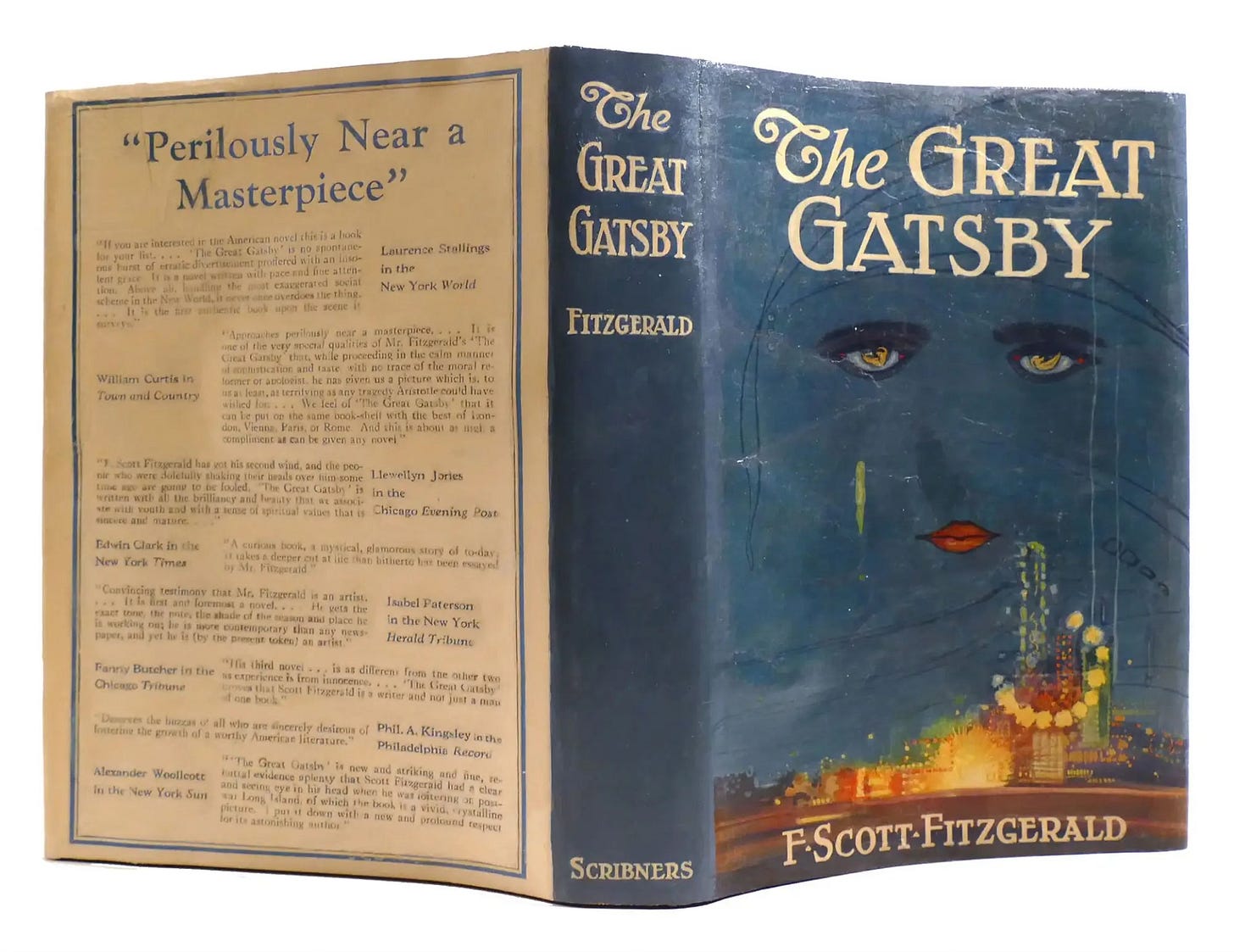I wasn’t going to post today, but it’s the centenary of when Charles Scribner’s Sons issued The Great Gatsby and set a new bar for quality American literature and storytelling. F. Scott Fitzgerald was already well-known and a bestseller based on his debut This Side of Paradise and short story collection Flappers and Philosophers. His second novel, The Beautiful and the Damned pretty much defines the “sophomore slump,” many authors face. The next novel, Tender is the Night is easily as good as Gatsby but it’s not as iconic or as American. The Love of the Last Tycoon might have been the best of them, had Fitzgerald lived to see it through.
To say that Gatsby is the great American novel is not just to praise its technique, lyricism, humor or structure, though all are hard to surpass, but its uniquely domestic subject matter, which is the American dream after the first World War. Huckleberry Finn and Uncle Tom’s Cabin addressed the American striving for freedom and dignity before and during the Civil War, and they deal with a wild, expanding country. The period after the Great War, with borders largely set and urbanization on the rise, is more readily recognizable to readers in 2025.
First, it’s a love story told over many years. Jay Gatz is a poor soldier who falls in love with Daisy Fay, a wealthy southern belle. He has to make his fortune before he can win her over. After the war, he sets about transforming himself into Jay Gatsby. He develops underworld connections, including a tough guy whose cufflinks are fashioned from human teeth (that he presumably extracted.) He develops a social circle around lavish parties. For Gatsby’s parties, Fitzgerald drew inspiration from The Satyricon by Petronius. The original title of the novel was Trimalchio of West Egg.
Gatsby cultivates the manners of an Ivy-educated Eastcoaster, frequently calling people “old sport,” though some characters see right through his charade: the suggestion that he is an Oxford Man is met with the quip, “Oxford, New Mexico,” and an owl-eyed party guest demonstrates that none of the books in Gatsby’s great library have ever been read, or even opened.
Gatsby has money but he’s playing the distinctly American social climbing game: “fake it, til you make it.” His fakery takes too long, though. Daisy Fay is now Daisy Buchanan, married to a boorish racist named Tom. Tom is obsessed with the race theories of Oswald Spengler and other writers of the time who argued that the ethnic diversification of the U.S. would lead to its decline. Those ideas never went away and some people who hold them hold positions of power even now.
The story is told to us by Nick Carraway a wry midwesterner who moved to New York to start a career selling bonds. One of Gatsby’s hustles, coincidentally, seems to have been forging bonds, a common practice in the 1920s. Carraway is also Daisy’s cousin and, as it happens, Gatsby’s neighbor. Once Gatsby makes the connection, he enlists Nick to try to help him get Daisy from Tom, putting Nick in a great position to see the story unfold.
Everybody but Nick is a cheater or grifter of some sort. Tom is sleeping with a mechanic’s wife behind Daisy’s back while stringing the mechanic along about selling him a valuable car. Nick briefly dates the golfer Jordan Baker, accused of cheating in her first major tournament. Gatsby, is likable a pseudo-person, who people want to believe in so that his parties will never end.
It ends with the deaths of dreams and people, some innocent, some not. Its themes have permeated American art and culture ever since: everybody wants to be rich, to have the perfect love, and to be free of the constraints of time and materiality. Gatsby had to become another person to pursue the woman he loved. But time would not pause for him to accomplish the task. This is true for all of us, no matter what we’re after — it’s not just the greed for money, power and status that defines the American mindset, it’s the urgency of it all and that sense that the harder you work, the more time becomes an obstacle to achievement.
Next year, we’ll celebrate the 100th birthday of Ernest Hemingway’s The Sun Also Rises. That’s also a great novel, maybe the great “Americans abroad” novel, but it doesn’t speak to our present day the way Gatsby does. But it’s worth noting that it’s Fitzgerald who introduced Hemingway to editor Max Perkins at Scribner’s, lifting Hemingway out of the world of privately funded small press editions in Paris and into commercial publishing. There are Fitzgerald partisans and Hemingway partisans and the two competed mightily in their time, but we would likely not have one without the other.



Gatsby is certainly a unique work, able to be viewed from several angles. FSF does 4 or 5 things at once in the novel, including fusing the romantic and the modern-- but also the "literary" at its best with pop motifs and a pop vibe. Gatsby, after all, is a bootlegger and gangster!